Tateshina Onsen
Soaking in a steaming hot spring is almost certainly a top entry in the to-do lists of prospective travelers planning a trip to Japan. After all, onsen bathing has always been a favored pastime among the nationals and has long become one of the country’s symbols. Thanks to its unflagging volcanic activity, Japan features countless onsens in every corner of the archipelago. Nagano Prefecture, in particular, stands out among the rest for having the second highest number of hot spring areas (over 200). Perched on top of high mountains, tucked away in scenic gorges, or channeled in decadent baths at picturesque ryokans, local springs come in all shapes, sizes, and colors. Among them is the sometimes overlooked, but actually impressively rich, Tateshina Onsen Area.
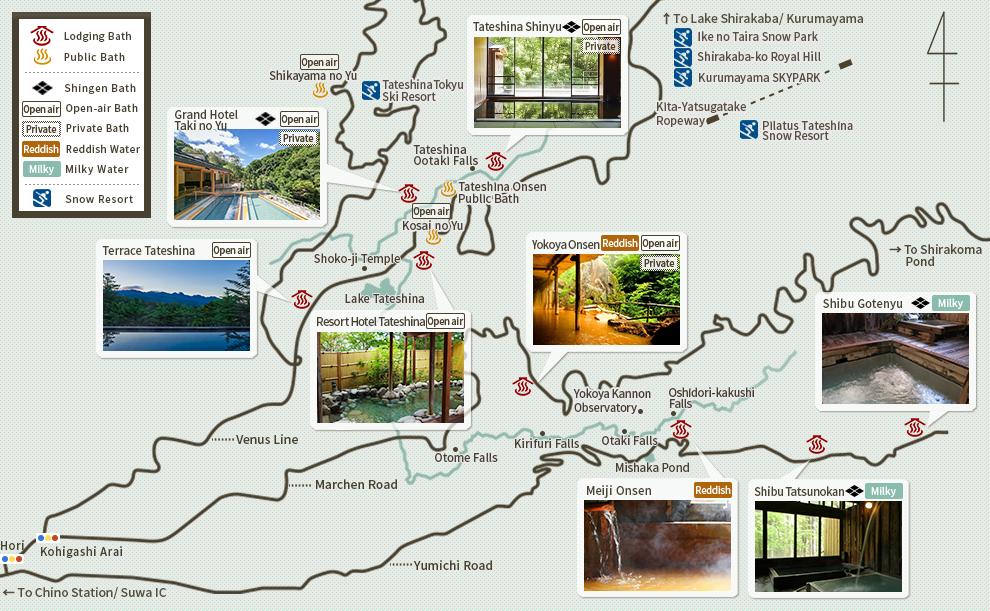
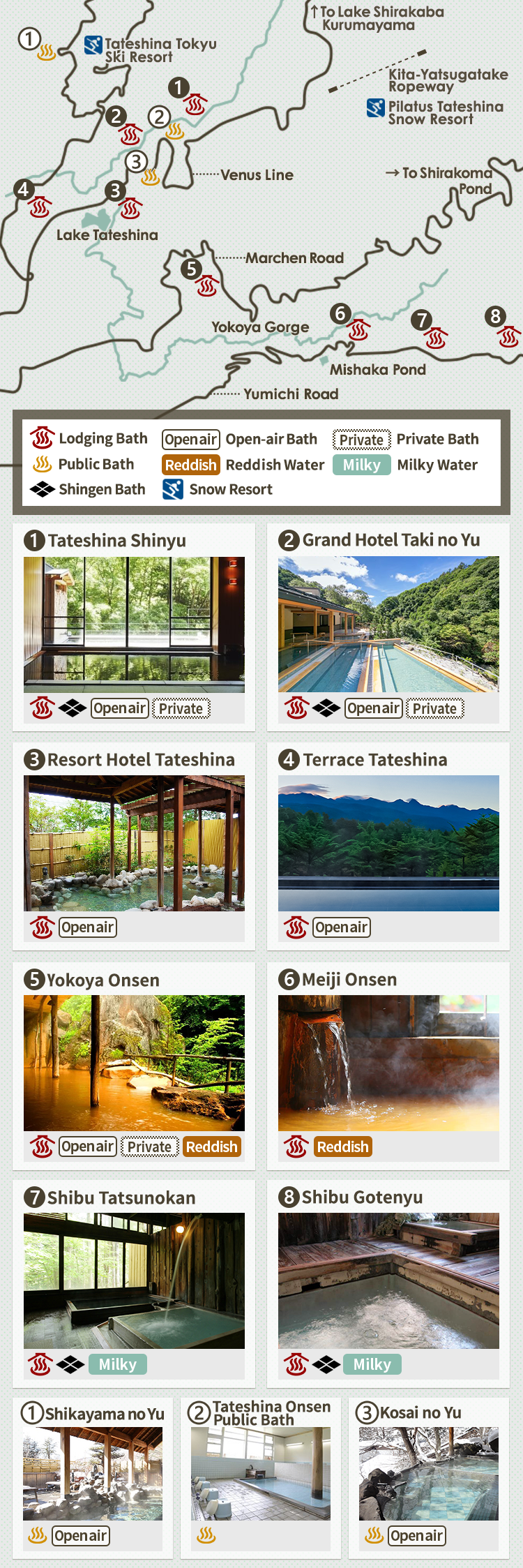
Why visit the Tateshina onsen area?
There are various reasons I could list on why you should consider Tateshina for you next onsen escapade. These include good access from Tokyo and several private-use baths available. However, in this article I would like to point out three I find particularly fascinating.
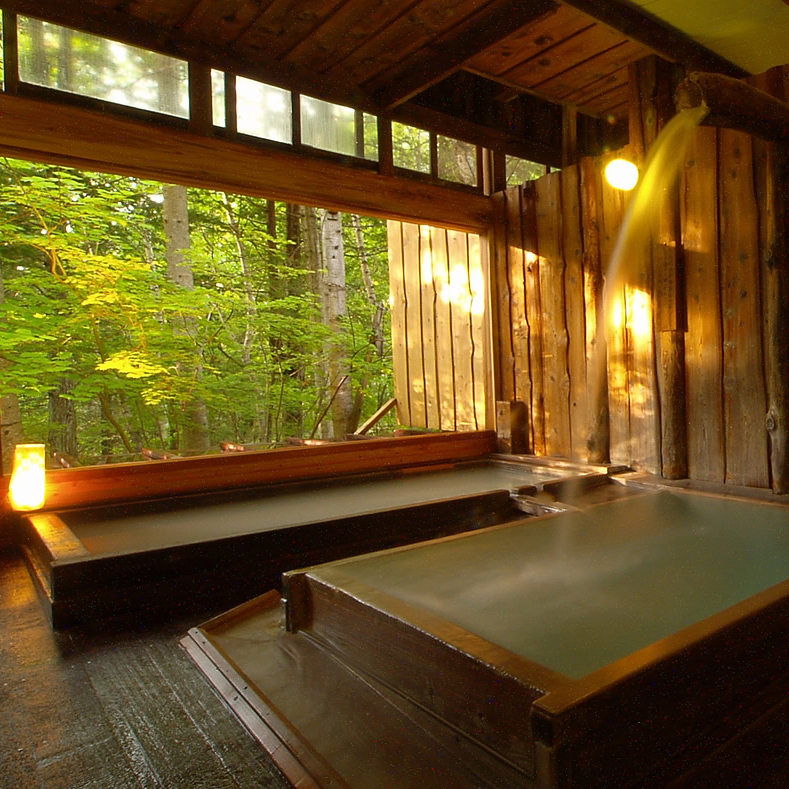

Wow factor no.1
Backstories worth of a history book!
Several onsens in Chino have an intriguing backstory. There is the hot spring whose location was disclosed to the high priest of Suwa Taisha in a revelatory dream, and then, there are Takeda Shingen’s secret baths. The Lord of the Takeda clan played an essential role in developing the Tateshina onsen resort area. It is him that 500 years ago first discovered the incredible healing properties of local onsen waters, where he and his loyal samurai warriors bathed to fix their battle wounds. The “miraculous” properties of the Tateshina onsens called people from all over Japan who embarked on long pilgrimages seeking to cure their ailments in their renowned waters.
Takeda Shingen’s Secret Hot Springs
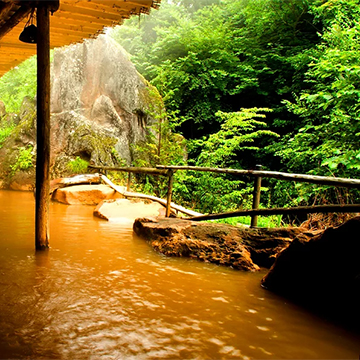

Wow factor no.2
A geothermal treasure trove with over eight different types of springs
There is not only one variety of onsen. Depending on its mineral composition, a hot spring’s appearance, smell, and beneficial properties noticeably change. There are over eight types of springs in the area, from ferruginous to sulphureous and carbonated springs, and all are rich in minerals. The reason for such richness and diverseness lies behind the geologic origin of the Yatsugatake Mountains, a long-extinct volcano.
Sulphureous Springs (Milky white ~Cobalt blue color)
When they think of thermal baths, most people probably imagine this kind. The high percentage of Sulphur confers the water an otherworldly milky or bright blue coloration, while giving off an unmistakable punchy smell that is often associated with rotten eggs (or demonic presence in horror flicks). Thanks to its ability to penetrate the keratin layer, this onsen is very effective in softening the skin and fighting atopy and similar conditions.
Ferruginous Springs (Reddish~Yellow color)
When coming into contact with the oxygen present in the atmosphere, the iron turns the water a rust-like color that can fade to orange or yellow once the iron sediment falls to the bottom of the bath. Their memorable tint likely makes this variety the most visually appealing. Careful, though, as the residue can easily stick to your skin and dye all your towels a clay-like shade.
Iron springs are great if you suffer from anemia, menstrual pain or menopause.
Alkaline Simple Thermal Springs
Simple springs are characterized by delicate water with a low mineral content, which stimulate epidermal growth. They are also known as “beauty springs,” as they make the skin supple and silky to the touch.
Sulfate Sodium Springs
The saline composition of these springs creates a film over the skin which helps retain warmth. They’re quite useful in winter, especially if you are up in the mountains.
Bicarbonate Springs
Bicarbonate springs have tiny bubbles which make the water feel a little fizzy at the touch. They emulsify skin fats and secretions making them easier to remove.
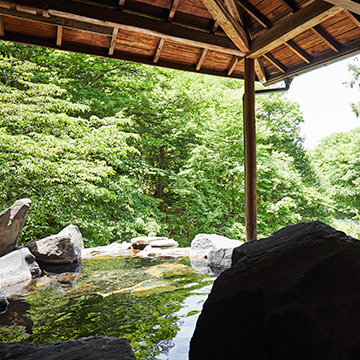

Wow factor no.3
Outstanding natural views
While some people seek certain baths for their therapeutic properties, others are more interested in the overall atmosphere and scenery you can savor at the onsen. Tateshina stands out in this area as well. Thanks to its ideal position halfway through the mountains, local baths offer dramatic views of tall peaks, lush gorges, and thick woods. The thermal experience, though, is not only appealing to the eye, but to all senses. When immersed in the hot water of the picturesque open-air baths, your ears are entertained by the lulling melody of gurgling rivers and waterfalls, and your nose is tickled by the sweet aroma of trees and flowers.
Hot springs with open-air baths
Lodgings with day-use baths
 Takeda Shingen’s Secret Baths
Takeda Shingen’s Secret Baths With open-air bath
With open-air bath Reddish waters
Reddish waters Milky waters
Milky waters Private bath
Private bath- Chino Covid Safe Guideline Certified Business* ※
※ This is an independent certification system developed by Chino City under the supervision of an infectious disease specialist. It establishes sanitation and cleaning guidelines aimed at keeping the risk of infection to a minimum in touristic establishments such as restaurants and lodgings.
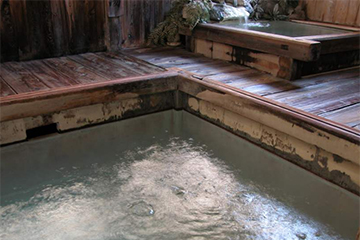

Shibu Gotenyu
- Chino Covid Safe Guideline STEP1
This Japanese inn is located in the Northern Yatsugatake, at an elevation of 1,800m. Thanks to its strategic position near the Shibu no Yu trailhead, one of the access points to Mt. Tengu-dake, it is a popular destination among alpinists. It is also one of Takeda Shingen's secret baths, where 500 years ago, the Kai Province lord's samurai warriors healed their wounds after a fight. The onsen composition has both acidic, sulphureous, and sulphate elements. It features a special spring called "Shibu Chojuyu" (meaning "long life onsen"), which flows naturally to the surface and presents a unique bubbly texture.
| Spring name | Shibu Chojuyu, Shibu Gotenyu |
|---|---|
| Appeal points | The water is milky and has a characteristic sulphureous smell. As it is very close to Shibu no Yu trailhead, you can use it to wash off the sweat after a long trek. |
| Day-use | Only Nishi no yu bath is available for day-use |
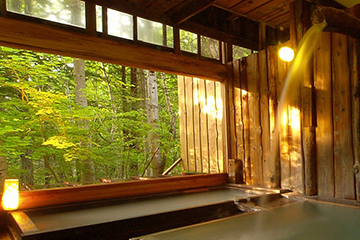

Shibu Tatsunokan
Shibu Tatsunokan is a traditional ryokan which exudes a quaint and nostalgic atmosphere. It is hidden away in a birch forest situated between Mishaka Pond and the Shibu no Yu trailhead. The inn was founded about 100 years ago, when it became a pilgrimage destination for people afflicted by various health conditions who sought the baths for their curative properties. Its portentous hot springs, though, have an even older history which dates back to the time of Takeda Shingen. Interestingly enough, a onsen does not necessarily have to be hot. The Yatsugatake area is characterized by many cold springs which only reaches a temperature of 20 degrees. Shibu Tatsunokan’s source also belongs to this last category, so you can experience taking turns in the cold and heated baths.
| Spring name | Shibu Kogensen |
|---|---|
| Appeal points | The water is milky and has a characteristic sulphureous smell. The long history of the inn transpires from every surface and wall. |
| Day-use | Available |
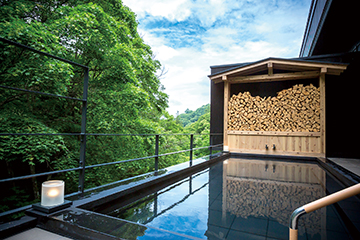

Tateshina Shinyu Onsen
- Chino Covid Safe Guideline STEP2
Shinyu Onsen is a "beauty spring," its light and delicate onsen water known for making the skin soft and silky.
The hotel’s five open-air baths offer a great view of the creek below, while the lulling gurgle of the mountain stream and the vibrant green of the surrounding forest helps you unwind.
The indoor bath features an unusual flooring with tatami mats instead of the usual tiles.
This is also one of Takeda Shingen's secret baths.
| Spring name | Shingen no Kakushiyu |
|---|---|
| Appeal points | There are a lot of baths to choose from, some of which you can use privately. The splendid view is also a perk. |
| Day-use | Day-use is temporarily suspended cause covid |
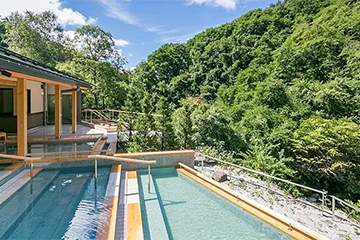

Tateshina Grand Hotel Taki no Yu
- Chino Covid Safe Guideline STEP2
Taki no Yu is a large resort hotel in the highland that can boast two private spring sources. Like the neighboring Shinyu, this onsen has a long history that goes back to the warring state period. The inn has several baths, but the most impressive is the outdoor terrace hot spring pool that juts out above the thunderous stream of Takinoyugawa River.
| Spring name | Taki no Yu Notenburo, Taki no Yu Onsen Motoyu |
|---|---|
| Appeal points | The panoramic terraced open-air bath overlooking Takinoyugawa River is really something. |
| Day-use | Available |
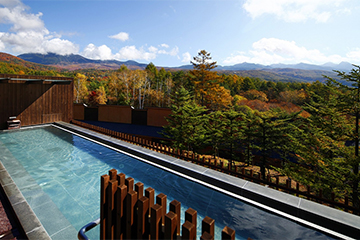

Terrace Tateshina Resort & Spa
Verdant gorges and crystalline creeks are not the only rewarding view you can expect in the area. Terrace Tateshina's 12-meter-long giant outdoor bath presents guests with the magnificent panorama of the Yatsugatake Mountain range. This is a member-only facility, but they accept reservations from the general public in the low season.
| Spring name | Tateshina Mimuro Gensen |
|---|---|
| Appeal points | The breath-taking mountain view from the pool-like bath is to die for. |
| Day-use | Day-use is temporarily suspended cause covid |
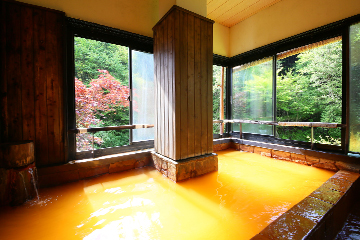

Meiji Onsen
- Chino Covid Safe Guideline STEP1
The hot springs at Meiji Onsen were first discovered in the Edo period by local farmers who bathed there to cure their aches. The outstanding properties of this onsen soon earned it the name meiji, which means "certain recovery from illness." The spring water is reddish, rich of iron, and naturally cold. Not unlike Shibu Tatsunokan, you can alternate soaking in the heated bath and cooling down in the cold one. The lodging faces the swift flow of the Oshidori-gakushi Falls and is just a 10-minute walk away from the suggestive Mishaka Pond.
| Spring name | Meiji Onsen |
|---|---|
| Appeal points | The water has a curious light red coloration that looks almost orange. This onsen is known for having a reinvigorating effect. |
| Day-use | Available |
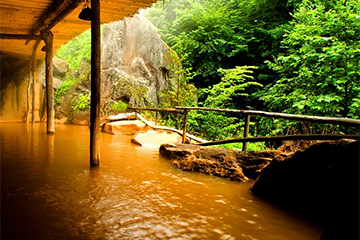

Yokoya Onsen Ryokan
- Chino Covid Safe Guideline STEP2
Tucked away in a lush gorge interwoven with waterfalls, Yokoya Onsen Ryokan is a traditional inn well-known for its ferruginous onsen baths. The red-colored hot springs and the mesmerizing prospect offered by yokoya the gorge facing the outdoor bath are two strong assets of this lodging. The Yokoya Onsen spring is effective against anemia, PMS, rheumatism, neuralgia, skin conditions, etc.
| Spring name | Yokoya Onsen |
|---|---|
| Appeal points | The sight of the gorge is truly beautiful, especially in autumn. The unusual reddish water rich in iron is also quite interesting. |
| Day-use | Day-use |
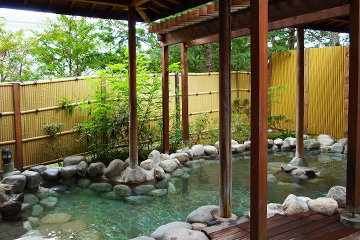

Resort Hotel Tateshina
- Chino Covid Safe Guideline STEP1
This accommodation has a great variety of baths; two indoors, one outdoors, and one consisting of large wooden barrels used as bathtubs. The Mimuro Gensen spring is characterized by slightly acidic water, which reaches uncommonly hot temperatures for Nagano prefecture. It is effective against digestive conditions, muscle pains, joint pains, etc.
| Spring name | Tateshina Mimuro Gensen |
|---|---|
| Appeal points | The bath assortment, which is made even more interesting by the added natural herbs and minerals, is worth a shot. |
| Day-use | Available |
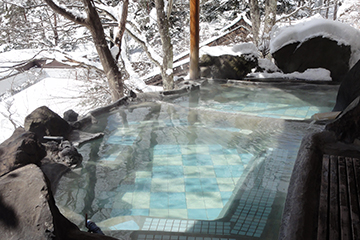

Kosai no Yu
Kosai no Yu has as many as six baths, an impressive number especially when you consider five of them are outdoors. The facility has an intriguing structure. It is built on a slope, with the various baths spread out on a vast surface and connected through mood-evoking roofed wooden corridors. Thanks to its elevated position at about 1,280m, while soaking in the onsen you can relish amazing views of the Japanese Alps. If you feel somewhat uncomfortable at bathing with strangers, you will be happy to know that here you will also find one private open-air bath.
| Spring name | Tateshina Mimuro Gensen |
|---|---|
| Appeal points | The unorthodox structure which allows you to explore, together with the magnificent view sets this facility aside from the rest. |
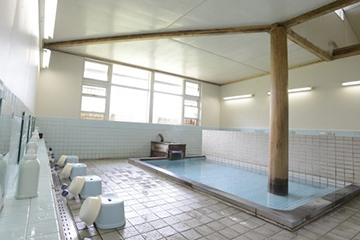

Tateshina Onsen Public Bathhouse
- Chino Covid Safe Guideline STEP1
Behind its austere and stark appearance, this is one of the most beloved hot springs in the area. With its somewhat small bath often livened by the chitchat of regulars, the Tateshina Onsen bathhouse gives off a nostalgic feeling. There are no showers and toiletries such as shampoo are not provided. You are supposed to bring your own soap and wash your body the old way, by scooping up water from the tub and use it to rinse. Its scalding onsen water is widely appreciated, as it relaxes your muscle and washes the fatigue away.
| Spring name | Tateshina Mimuro Gensen |
|---|---|
| Appeal points | The hot onsen water (around 43 degrees), together with the at-home atmosphere are great. |
Public Baths run by the City
Hot springs are so common in Chino that there are seven bathhouses (each for every district)run directly by the city. We are not talking about sentos, where you soak in ordinary hot water, but proper natural hot springs.
As they are targeted to the local people, they have lower prices for the residents, but are overall the most affordable options for travelers too. They are also convenient. As a rule, they are provided with large resting rooms, indoor and outdoor baths, basic toiletries (rinse-in-shampoo and body soap), vending machines, and often small eateries.
*Currently, as a precaution against the spread of covid, you are required to register your name and contact information at the counter.
Shiotsubo no Yu (Yonezawa area/ near Tateshina Jiyu Noen Farmer’s Market)- Sulfate Sodium Acidic Springs
Bogaku no Yu (Tamagawa area)- Alkaline Simple Thermal Springs
Kinkei no Yu (Kanazawa area)- Alkaline Simple Thermal Springs
Aqualand (downtown area-20 min on foot from Chino Station)- Alkaline Simple Thermal Springs
Kawara no Yu (Izumino area)- Simple springs
Suzuran no Yu (Lake Shirakaba)- Simple springs

